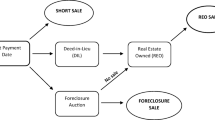Abstract
Despite a recent upturn, housing prices remain in flux in most cities nationwide. Lenders are still left dealing with a glut of distressed properties. They can choose to foreclose on the property or allow the owner/mortgagor to attempt to sell the property for less than the outstanding balance of the mortgage in a short sale agreement. The best way to clear the market of distressed properties is an important policy question. This is the first study to examine not only the price and time on market effect of being a short sale but also whether the short sale process itself creates a market stigma.
Similar content being viewed by others
Notes
The term has come to be generally accepted to mean a property on which its existing loan amount is greater than its property value.
In fact, it is common for many parties such as Home Owner Associations, local taxing authorities, and other stakeholders to become either directly or indirectly involved in the process.
Again, please note that non-distressed here references properties being marketed that are neither foreclosures nor short sales.
Some might be uncomfortable with the exposition of the models for price and marketing span due to technically incorrect subscripts. However, this method of exposition is chosen for its compactness in explaining how price and days on market are typically modeled. A simple glance at the Exhibits for estimating selling price and days on market should resolve any questions of model specification.
With respect to Miller (1978), this finding is not uncommon. In a working paper by Benefield and Hardin, the authors point out that despite the recognized relationship between price and time on market the relationship ranges between positive and significant to negative and significant to statistically insignificant across numerous works. The author’s suspect this is in part due to measurement error.
When the dependent variable in a regression is log-transformed (such as lnSP in this example), the coefficient of an independent variable that has not been similarly transformed would be interpreted by using an exponential function. Further discussion of these issues may be referenced here: https://www.cscu.cornell.edu/news/statnews/stnews83.pdf
References
Allen, M.T., Benefield, J.D., and Cain, C.L. (2013). The Time-Varying Nature of Short Sale Price Discounts, Marketing Time Impacts, and Probability of Sale Effects. Working Paper
Anderson, C. W., & Beracha, E. (2010). Home price sensitivity to capital market factors: analysis of zip code data. Journal of Real Estate Research, 32, 161–185.
Archer, W. R., & Smith, B. C. (2013). Residential mortgage default: the roles of house price volatility, euphoria and the Borrower’s put option. Journal of Real Estate Finance and Economics, 46, 355–378.
Aroul, R. R., & Hansz, J. A. (2014). The valuation impact on distressed residential transactions: anatomy of a housing price bubble. Journal of Real Estate Finance and Economics, 49, 277–302.
Brastow, R. T., Springer, T. M., & Waller, B. D. (2012). Efficiency and incentives in residential brokerage. Journal of Real Estate Finance and Economics, 45, 1041–1061.
Case, K. E. (2008). The central role of home prices in the current financial crisis: how will the market clear? Brookings Papers on Economic Activity, 2, 161–193.
Clauretie, T. M., & Daneshvary, N. (2011). The optimal choice for lenders facing defaults: short sale, foreclose, or REO. Journal of Real Estate Finance and Economics, 42, 504–521.
Daneshvary, N., & Clauretie, T. M. (2012). Toxic neighbors: foreclosures and short-sale spillover effects from the current housing-market crash. Economic Inquiry, 50, 217–231.
Diamond, D. W., & Verrecchia, R. E. (1987). Constraints on short-selling and asset price adjustment to private information. Journal of Financial Economics, 18, 277–311.
Goetzmann, W. N., Peng, L., & Yen, J. (2011). The subprime crisis and house price appreciation. Journal of Real Estate Finance and Economics, 44, 36–66.
Goodwin, K. R., Johnson, K. H., & Zumpano, L. V. (2012). Minimum service requirements, limited service brokers and Menuing of services. Journal of Real Estate Finance and Economics, 45, 471–490.
Harding, J. P., Rosenblatt, E., & Yao, V. W. (2009). The contagion effects of foreclosed properties. Journal of Urban Economics, 66, 164–178.
Haurin, D. (1988). The duration of marketing time of residential housing. Journal of the American Real Estate and Urban Economics Association, 6, 396–410.
Huang, J., & Rutherford, R. C. (2007). Who you going to call? Performance of realtors and non-realtors in a MLS setting. Journal of Real Estate Finance and Economics, 35, 77–93.
Johnson, K. H., Benefield, J. D., & Wiley, J. A. (2008). The probability of sale for residential real estate. Journal of Housing Research, 16, 131–142.
Leonard, T., & Murdock, J. C. (2009). The neighborhood effects of foreclosure. Journal of Geographical Systems, 11, 317–322.
Lin, Z., Rosenblatt, E., & Yao, V. W. (2009). Spillover effects of foreclosures on neighborhood property values. Journal of Real Estate Finance and Economics, 38, 387–407.
Miller, N. G. (1978). Time on the market and selling price. Journal of the American Real Estate and Urban Economics Association, 6, 164–174.
Pavlov, A., & Wachter, S. (2011). Subprime lending and real estate prices. Real Estate Economics, 39, 1–17.
Rutherford, R. C., Springer, T. M., & Yavas, A. (2005). Conflicts between principals and agents: evidence from residential brokerage. Journal of Financial Economics, 76, 627–665.
Saffi, P. A. C., & Sigurdsson, K. (2011). Price efficiency and short selling. Review of Financial Studies, 24, 821–852.
Schuetz, J., Been, V., & Ellen, I. G. (2008). Neighboring Effects of Concentrated Mortgage Foreclosures. Journal of Housing Economics, 17, 306–319.
Zuehlke, T. W. (1987). Duration dependence in the housing market. The Review of Economics and Statistics, 69, 701–709.
Author information
Authors and Affiliations
Corresponding author
Rights and permissions
About this article
Cite this article
Goodwin, K.R., Johnson, K.H. The Short Sale Stigma. J Real Estate Finan Econ 55, 416–434 (2017). https://doi.org/10.1007/s11146-016-9571-2
Published:
Issue Date:
DOI: https://doi.org/10.1007/s11146-016-9571-2




